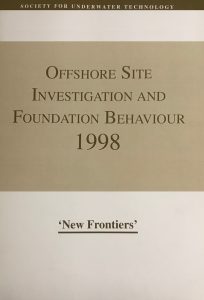Offshore Site Investigation and Foundation Behaviour 1998: ‘New Frontiers’
 Proceedings of an International Conference held 22-24 September 1998
Proceedings of an International Conference held 22-24 September 1998
ISBN 0 906940 338, Softbound, 1998
As the offshore industry moves steadily into deeper water, and the use of man and manned vehicles becomes increasingly dangerous, expensive and impracticable, so the tools of remote intervention have to be developed and exploited. These proceedings promote these technologies, and are applicable to a variety of industries, including hydrocarbon exploration companies, defence industries, deep ocean mineral exploitation, and salvage operations.
The volume contains papers, presented at an SUT international conference on 10-12 April 1997, by specialists in remote intervention and robotic technology, analysing state-of the-art systems. The authors look ahead at other technologies that can be utilised, emphasising industry’s requirements for the next millennium under the sea.
Contents
New Frontiers-The Challenges
- Opening Address – D Walker, BP Exploration, USA
- Future Geophysical Site Investigation: Looking for an Improved Depth of Field and Sharpened Focus – A Hill, BP Exploration, USA
- Deepwater Development-The Metocean Challenges – C Graham, Shell International Deepwater Services BV, The Netherlands
- Sedimentary Processes on the Continental Slope-Perspectives for Site and Hazard Investigation – DG Masson et al, Southampton Oceanography Centre
- Geotechnical Challenges West of Shetland – TG Evans et al, BP Exploration; McDermott Marine Construction Ltd, Kvaerner Oil and Gas; Aker Marine Contractors; and Cofleip Stena Offshore
Geohazards
- The Investigation of Deepwater Geohazards Using Short Offset, High-Resolution Marine 3D Equipment – C Sonnier, John E Chance & Associates, Fugro, USA
- Glory Hole Construction and Trenching Challenges, Offshore Canada – M Finch, Coflexip Stena Offshore, UK
- Geohazards on the Continental Slope West of Shetland – A Read, Maritech Consultants, UK
Deepwater-Regional Assessments
- The Western Frontiers Association- an Example of Joint Industry Funded Regional Studies of the Shallow Geology in a Frontier Region – D Long et al, British Geological Survey, UK; Shell Exploration and Production, UK; and BP Exploration Inc, USA
- Use of Integrated Study to Characterize the Marlin Deepwater Site – P Jeanjean et al, Amoco Corporation, USA; Fugro-McClelland Marine Geosciences Inc, USA, and Norwegian Geotechnical Institute, Norway
- Shallow Gas Migration Mechanisms in Deep Water Sediments – AG Judd, University of Sunderland, UK; and RH Sim, Fugro-Geoteam, UK
- The GEOSIS Method for Integrating VHR Seismic an Geotechncal Data in Offshore Site Investigations – J-F Nauroy et al, Institut Fran-ais du P-trole; Total; and IFREMER, France
- Sample Disturbance effects in Deep Water Soil Investigations – T Lunne et al, Norwegian Geotechnical Institute, Norway
- Improved Seabed Strength Profiling Using T-Bar Penetrometer – MF Randolph et al, University of Western Australia and Advanced Geomechanics; and Fugro Engineers BV, The Netherlands
- A Review of Soil-Steel Interface Testing with the Ring Shear Apparatus – N Ramsey et al, Fugro, UK; Imperial College, UK; and Trinity College, Ireland
- Minimal Intervention DCS for Well Buoy Applications – RA Hawkins, Fugro Ltd, UK; and A Markus, Fugro Engineers BV, The Netherlands
Foundation Behaviour, Part I-Suction Foundation
- Behaviour of Miniature Suction Cassions in Clay – AJ Whittle et al, Massachusetts Institute of Technology, USA; and Dames and Moore, USA
- Pull-out Capacity of Bucket Foundations in Soft Clay – L Zdravkovic et al, Imperial College of Science, Technology and Medicine, UK
- Comparison and Back Calculation of Penetration Resistance from Suction Anchor Installation in Soft to Stiff Clay at the Njord and Visund Fields in the North Sea – E Solhjell et al, Norwegian Geotechnical Institute; and Norsk Hydro, Norway
- Foundation Behaviour, Part II-Piled and Gravity Based Structures
- Foundation Design of Wandoo B Concrete Gravity Structure – C Humpheson, Arup Geotechnics, UK
- The Applicability of the New Imperial College Pile Design method to Calcerous Sands – GWL Thompson, Brown and Root Energy Services, UK; and RJ Jardine, Imperial College of Science, Technology and Medicine
- The Implications of the Load and Resistance Factor Design Method for North Sea Pile Design – AKC Smith et al, Fugro Ltd; and BOMEL Ltd, UK
Pipelines
- Design and Operation of a Seafloor Burial Asessment System – TM McGinnis and ME Williamson, Williamson and Associates Inc, USA
- Geotechnical Investigation for Performance Prediction of Submarine Trenching Ploughs – PG Allan, SEtech Ltd, UK
- Pipeline Foundation Considerations – M Finch, Coflexip Stena Offshore, UK; and JB Machin, Ceanic Corp, USA
Case Studies
- Frontier Geohazard Site Investigations-Experiences from the Caspian Sea – R Orren and I Hamilton, Fugro-Geoteam Ltd, UK
- Advances in Technology for Integrated Route Analysis – NT Carey et al, SAGE Engineering; and Mentor Engineering, UK
- Safety Implications for Offshore Foundations of Conductor and Shallow Well Drilling – R Hobbs and DWF Senner, Lloyd’s Register Offshore Services, UK
- Endurance and Stabillity of Steel Structures on the Seabed – R Haworth et al, SLP Engineering; Oxford University; and Kvaerner Process, UK